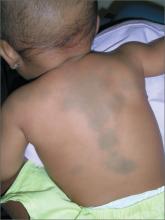The FP recognized this as a case of dermal melanocytosis, also known as Mongolian spots. She reassured the mother that the spots would fade over time and were not dangerous. There were no suspicions of abuse, but the physician inquired about the child's safety and environment to avoid missing any red flags.
A Mongolian spot is a hereditary, congenital macule of bluish-black or bluish-gray pigment that usually occurs in the sacral area, back, and buttocks of infants. The spots result from entrapment of melanocytes in the dermis during their migration from the neural crest into the epidermis.
Mongolian spots have been reported in approximately 96% of black infants, 90% of Native American infants, 81% to 90% of Asian infants, 46% to 70% of Hispanic infants, and up to 10% of white infants. A few cases of extensive Mongolian spots have been reported with inborn errors of metabolism, the most common being Hurler syndrome, followed by gangliosidosis type 1, Niemann-Pick disease, Hunter syndrome, and mannosidosis. In such cases, the spots are likely to persist rather than resolve.
There are also reports of Mongolian spots being mistaken for the bruising that occurs from child abuse. A thorough history and a clear knowledge of the pattern of Mongolian spots should help to differentiate between the 2. Mongolian spots are likely to fade over time and may disappear by age 13.
Photos and text for Photo Rounds Friday courtesy of Richard P. Usatine, MD. This case was adapted from: Fernandez C, Smith M. Normal skin changes. In: Usatine R, Smith M, Mayeaux EJ, et al, eds. Color Atlas of Family Medicine. 2nd ed. New York, NY: McGraw-Hill; 2013: 629-635.
To learn more about the Color Atlas of Family Medicine, see: www.amazon.com/Color-Family-Medicine-Richard-Usatine/dp/0071769641/
You can now get the second edition of the Color Atlas of Family Medicine as an app by clicking on this link: usatinemedia.com


